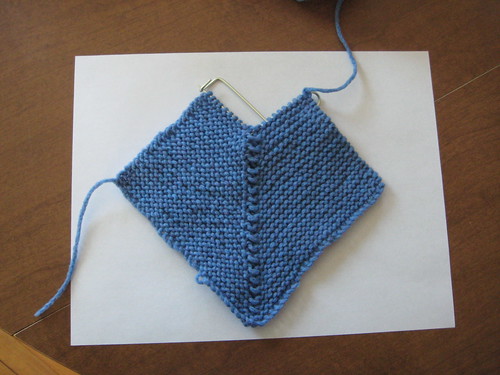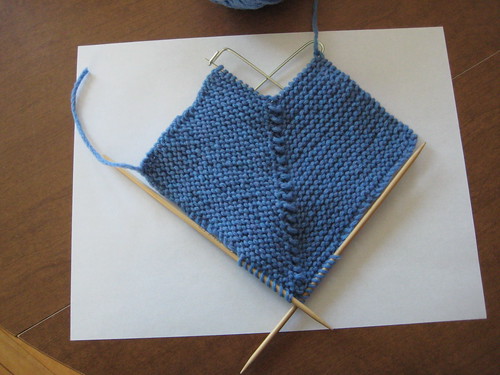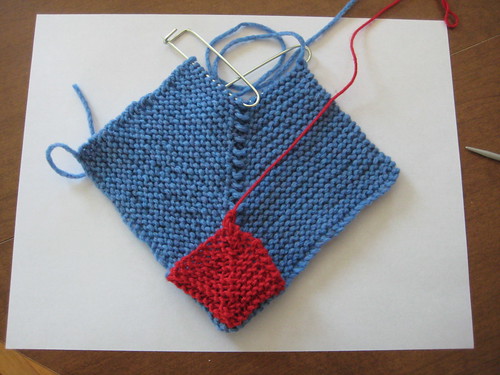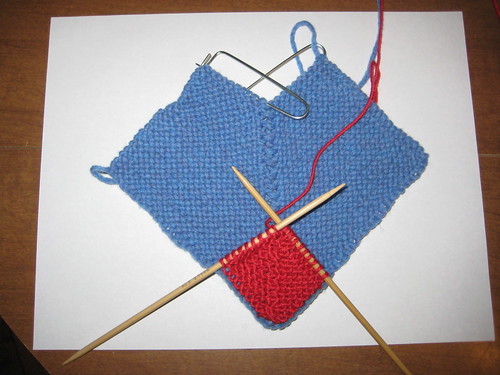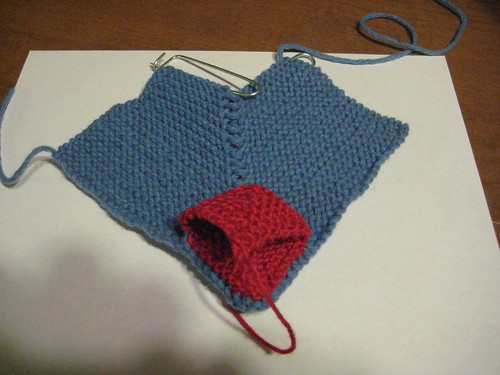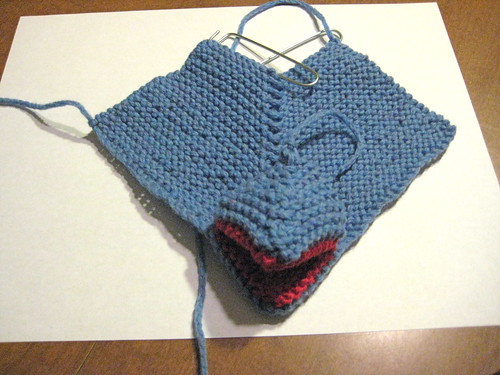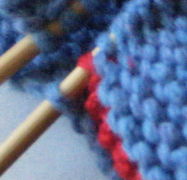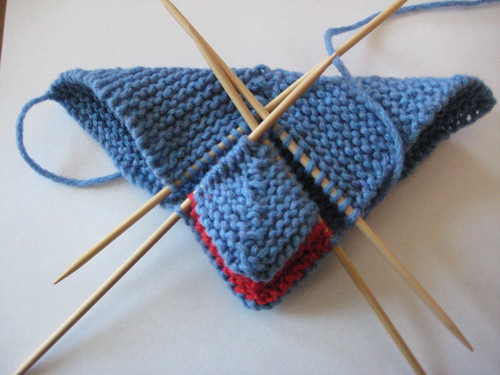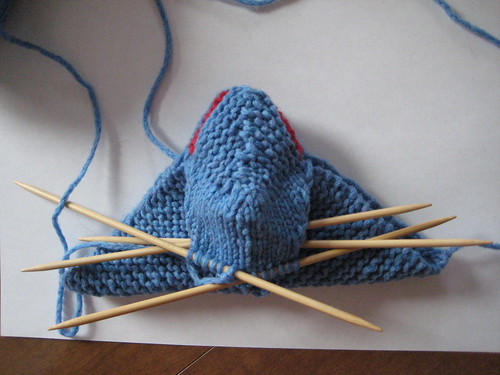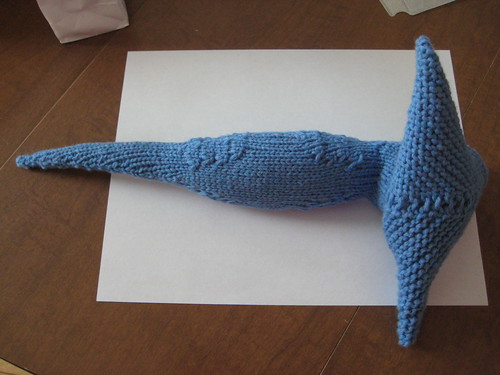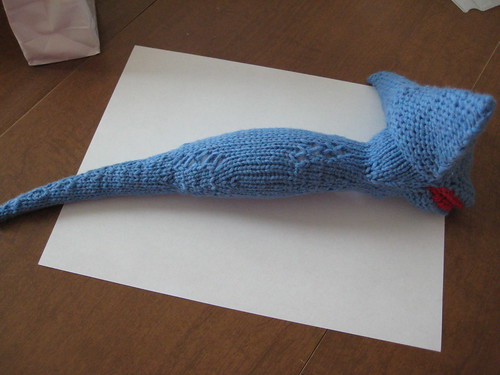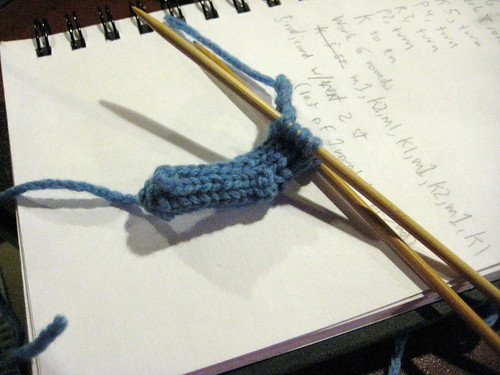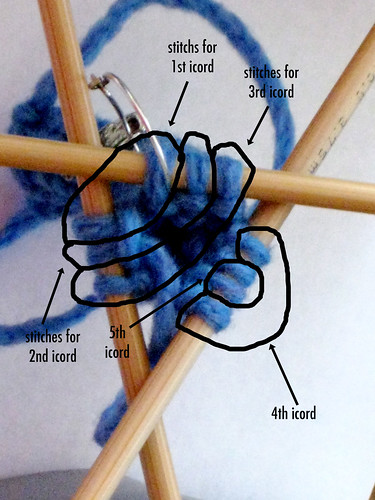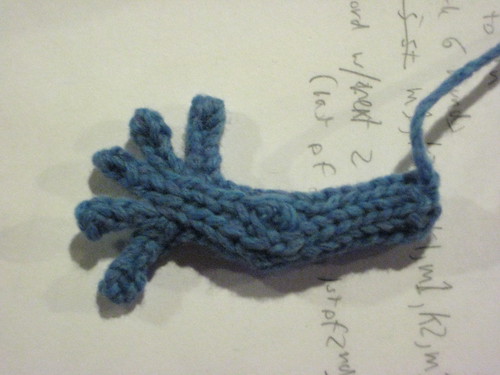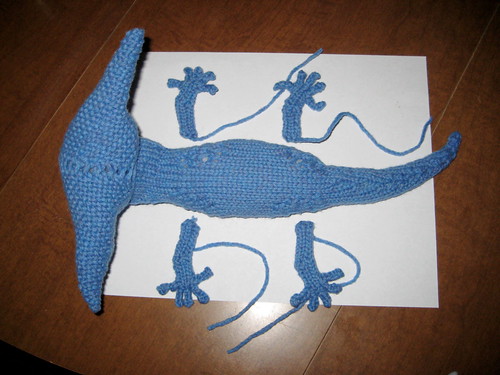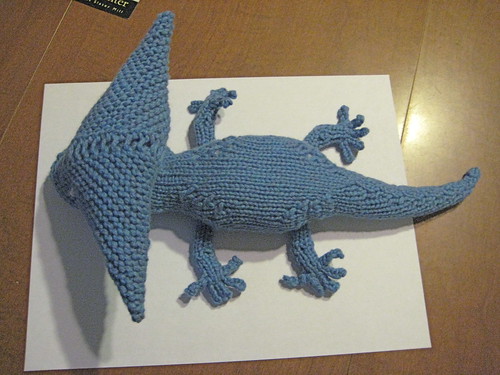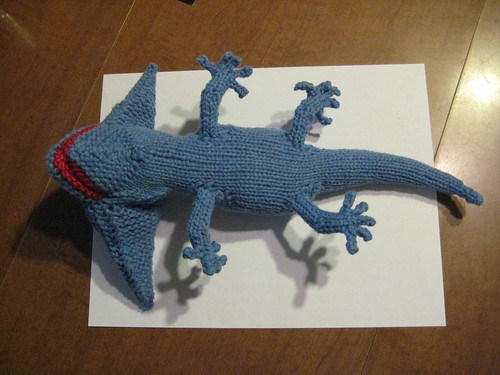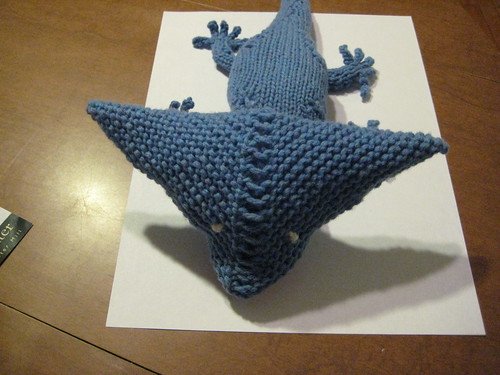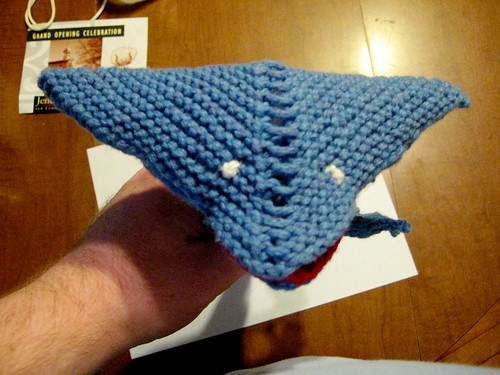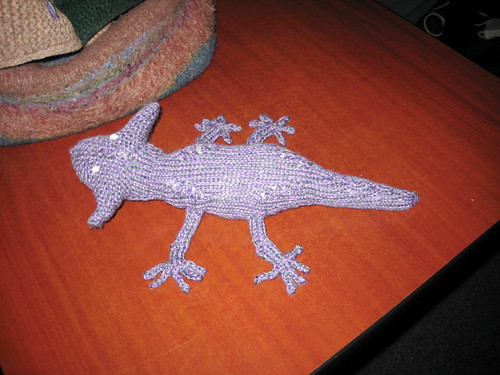[Jake's other knitting patterns and links]
Knitted Diplocaulus Pattern
Thanks to Karla Zimonja for giving me the original inspiration to design this. A Diplocaulus is a primitive amphibian that lived in the Permian period, roughly 250-300 million years ago. It could be up to about a meter long. There seem to be a bunch of different ideas regarding exactly what it looked like; I took the liberty of basing my knitted one on some of the cuter versions.
MATERIALS
You will need:
- Roughly 100 yards of yarn in the color you've picked for your Diplocaulus. Any bulky or worsted weight yarn should be fine.
- Roughly 30 yards of yarn in the color you've picked for its mouth.
- A scrap of yarn for the eyes.
- Poly fill to stuff the body and head.
- Size 5 DPNs. (If you're using a different weight of yarn, use needles a size or two smaller than that recommended on the yarn's label so the stitches will be extra-tight.)
- Size 5 straight needles. (These are optional -- you can just use the DPNs called for above -- but I found they made making the head easier.)
- Two stitch holders.
- A tapestry needle to sew things together and embroider the eyes.
HEAD
Top of head:
- Cast on 60 stitches.
- K30, place marker, K2tog, K to end.
- K to mark, K2tog, K to end.
- Repeat until 20 stitches remain, 10 on each side of the marker.
- Place remaining stitches on stitch holders, removing marker.
Mouth:
On cast on edge, pick up 10 stitches on either side of the center point (20 stitches total). (I generally find it easiest to pick the stitches up on two double-pointed needles, then on the first row below knit across on a single straight needle or DPN.)
In mouth color, work as follows:
- Row 1: K9, K2tog, K9
- Row 2: K9, K2tog, K8
- Row 3: K8, K2tog, K8
- Row 4: K7, K2tog, K8
- Row 5: K7, K2tog, K7
- Row 6: K7, K2tog, K6
- Row 7: K6, K2tog, K6
- Row 8: K5, K2tog, K6
The 'K2tog's should all more or less line up. Continue until 1 stitch remains and bind off.
Pick up 10 stitches along each the free edges of the square just knit (20 stitches total)
and repeat the above using the mouth color.
Pick up 10 stitches along the free edges of the square just knit and repeat one last time, this time in the body color.
Neck:
On each side of the mouth (using a separate DPN for each), pick up one stitch each from the top lip and inside of the mouth, then ten stitches from the free edges of the square just knit.
(This makes 12 stitches on each DPN for a total of 24.)
Move the stitches from the top of the head that are currently on stitch markers back to DPNs (10 stitches per DPN).
Fold the top of the head so that the four DPNs are now adjacent and on top of the piece. Starting with the chin and going around clockwise, you've now got:
- 12 stitches on the left front DPN (from the mouth).
- 10 stitches on the left back DPN (from the top of the head).
- 10 stitches on the right back DPN (from the top of the head).
- 12 stitches on the right front DPN (from the mouth).
44 stitches total. You will work the stitches in that order.
Starting with the chin (place marker if desired), work in the round as follows, rearranging the stitches on the needles as necessary:
- Round 1: K10, k2tog, K19, K2tog, K2tog, K9 (41 st)
- Round 2: K9, K2tog, K2tog, K18, K2tog, K8 (38 st)
- Round 3: K8, K2tog, K18, K2tog, K8 (36 st)
- Round 4: K8, K2tog, K15, K2tog, K2tog, K7 (33 st)
- Round 5: K7, K2tog, K2tog, K13, K2tog, K7 (30 st)
- Round 6: K7, K2tog, K12, K2tog, K7 (28 st)
- Round 7: K6, K2tog, K12, K2tog, K6 (26 st)
- Round 8: K6, K2tog, K10, K2tog, K6 (24 st)
- Round 9: K5, K2tog, K10, K2tog, K5 (22 st)
- Round 10: K5, K2tog, K8, K2tog, K5 (20 st)
Knit 3 rounds. Leave yarn on DPNs, sew up the sides of the head, and insert stuffing. Concentrate the stuffing on the center of the head and use just enough to give it a little interior support; the head's structure should be relatively stiff, so it shouldn't be necessary to really pack the stuffing in.
BODY AND TAIL
Throughout this section of the pattern, you should stop every 5-10 rows to stuff the section you've just knit.
- Row 1: K4, Kfb, K10, Kfb, K4 - 22 st
- Row 2: K8, w&t, P4, w&t, K14, w&t, P4, w&t, K8
- Row 3: K5, Kfb, K10, Kfb, K5 - 24 st
- Row 4: K8, w&t, P4, w&t, K16, w&t, P4, w&t, K8
- Row 5: K5, Kfb, K12, Kfb, K5 - 26 st
- Row 6: K9, w&t, P4, w&t, K16, w&t, P4, w&t, K9
- Row 7: K6, Kfb, K12, Kfb, K6 - 28 st
- Row 8: K9, w&t, P4, w&t, K18, w&t, P4, w&t, K9
- Row 9: K6, Kfb, K14, Kfb, K6 - 30 st
- Rows 10-22: K 13 rounds
- Row 23: K6, K2tog, K14, K2tog, K6 - 28 st
- Row 24: K9, w&t, P4, w&t, K18, w&t, P4, w&t, K9
- Row 25: K6, K2tog, K12, K2tog, K6 - 26 st
- Row 26: K9, w&t, P4, w&t, K16, w&t, P4, w&t, K9
- Row 27: K5, K2tog, K12, K2tog, K5 - 24 st
- Row 28: K8, w&t, P4, w&t, K16, w&t, P4, w&t, K8
- Row 29: K5, K2tog, K10, K2tog, K5 - 22 st
- Row 30: K8, w&t, P4, w&t, K14, w&t, P4, w&t, K8
- Row 31: K4, K2tog, K10, K2tog, K4 - 20 st
- Row 32: K4, K2tog, K8, K2tog, K4 - 18 st
- Row 33: K 1 row
- Row 34: K8, K2tog, K to end - 17 st
- Row 35: K 1 row
- Row 36: K8, K2tog, K to end - 16 st
- Rows 37-38: K 2 rows
- Row 39: K7, K2tog, K to end - 15 st
- Rows 40-41: K 2 rows
- Row 42: K7, K2tog, K to end - 14 st
- Rows 43-44: K 2 rows
- Row 45: K6, K2tog, K to end - 13 st
- Rows 46-47: K 2 rows
- Row 48: K6, K2tog, K to end - 12 st
- Rows 49-50: K 2 rows
- Row 51: K5, K2tog, K to end - 11 st
- Rows 52-53: K 2 rows
- Row 54: K5, K2tog, K to end - 10 st
- Rows 55-56: K 2 rows
The 'K2tog's should line up. Continue in this way until 3 stitches remain, stuffing as you go. Break yarn, pass through remaining stitches, and work the yarn ends into the interior of the diplocaulus.
LEGS (make 4)
Leaving a 6-8 inch tail of yarn (which will later be used to sew the leg onto the Diplocaulus body), cast on 6 stitches and work in the round for 8 rows.
These next stitches define the leg's elbow or knee:
- K5, turn
- P4, turn
- K3, turn
- P2, turn
- K to end.
Work six rounds.
On the next row:
- m1, K2, m1, K1, m1, K2, m1
There should now be one stitch remaining in the round (for a total of ten stitches). Using this stitch and the first stitch of the next round, work as 2-stitch icord for five rounds, then break off yarn and pass yarn through the two icord stitches.
Now take the last remaining stitch from the round (the one created by the final m1 above) and the second stitch of the next round and again work as a 2-stitch icord for five rounds, break off yarn, etc. If you are having trouble visualizing how this works, this diagram may help:
Continue in this way, creating 2-stitch icords using stitches from the beginning and end of the round, until you have created five icords.
Work in yarn ends.
It is not necessary to put any stuffing in the legs.
ASSEMBLY
Sew legs onto body as shown. The top of the legs should be slightly below the line of 'Kfb's and 'K2tog's in the body.
Work in ends. Embroider eyes.
NOTE
If different-sized head is desired, feel free to increase or decrease the number of stitches cast on in the 'HEAD' section of the pattern as desired. You must cast on at least 40 stitches in order for the pattern to work, but other than that there's no limit on the number of stitches used, as long as you use an even number of stitches.
These lines should be the only ones you need to modify:
Cast on 60 stitches. -- change this to the number of stitches you cast on
K30, place marker, K2tog, K to end. -- change '30' to half of the number of stitches you cast on.
Here's a 40-stitch cast-on Diplocaulus, the smallest sized head possible:
As always, if you have any questions or comments, please let me know!
|
|
|
|
|
|
|
|
|
|
|
|
